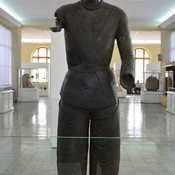Es gibt noch keine deutschsprachige Anmerkungen. Präsentiert wirden Anmerkungen auf English.
The temple of Shami was built in the centre of rectangular outer wall 23x12 m. built of stone. The shrine itself was presumably built of bricks. There are unearthed burnt bricks altar, stone bases for statues of deitis and rulers and thymiateria.
See:
- Vesta Sarkhosh Curtis, “A Parthian Statuette from Susa and the Bronze Statue from Shami.” Iran, vol. 31, 1993, pp. 63–69. JSTOR, www.jstor.org/stable/4299887.
- Handbuch der Orientalistik: Der Nahe und der Mittlere Osten, BRILL, 1991, pp. 42-16
- Jafar Mehr Kian and Vito Messina, The Sanctuary and Cemetery of Shami. Research of the Iranian-Italian Joint Expedition in Khuzestan at Kal-e Chendar, State Hermitage Museum and Institute of Oriental Manuscripts, Russian Academy of Sciences, in St Petersburg, 2019, pp. 271-285
- Vito Messina, Mehr Kian, The sanctuary and cemetery of Shami: research of the Iranian-Italian joint expedition in Khuzistan at Kal-e Chendar , Pavel Lurje,(Ed..) , Proceedings of the 8th European Conference of Iranian Studies. Held on 14–19 Sep. 2015 at the State Hermitage Museum and Institute of Oriental Manuscripts, Russian Academy of Sciences, in St Petersburg. Vol. 1: Studies on Pre-Islamic Iran and on Historical Linguistics. St. Petersburg: The State Hermitage Publishers, 2019, pp. 271-284 (https://www.academia.edu/40406867/THE_SANCTUARY_AND_CEMETERY_OF_SHAMI_RESEARCH_OF_THE_IRANIAN_ITALIAN_JOINT_EXPEDITION_IN_KHUZISTAN_AT_KAL_E_CHENDAR)

